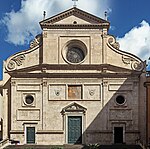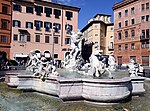Palazzo di Sant'Apollinare
Houses completed in the 16th centuryPalaces in Rome

The Palazzo di Sant'Apollinare is a building on Piazza di Sant'Apollinare 49, Rome. It is named for Apollinaris of Ravenna. The palace (palazzo) is part of a large complex that has hosted a number of institutions, including Basilica di Sant'Apollinare, the Collegium Germanicum et Hungaricum, the Pontifical Roman Seminary, and the Pontifical Institute of Sant’Apollinare. The Pontifical University of the Holy Cross is located in the Palazzo. Since its beginning in 1984, more than 7,000 students from 102 countries have passed through.
Excerpt from the Wikipedia article Palazzo di Sant'Apollinare (License: CC BY-SA 3.0, Authors, Images).Palazzo di Sant'Apollinare
Piazza di Sant'Apollinare, Rome Municipio Roma I
Geographical coordinates (GPS) Address Website Nearby Places Show on map
Geographical coordinates (GPS)
| Latitude | Longitude |
|---|---|
| N 41.90074 ° | E 12.47351 ° |
Address
Pontificia Università della Santa Croce
Piazza di Sant'Apollinare 49
00186 Rome, Municipio Roma I
Lazio, Italy
Open on Google Maps










